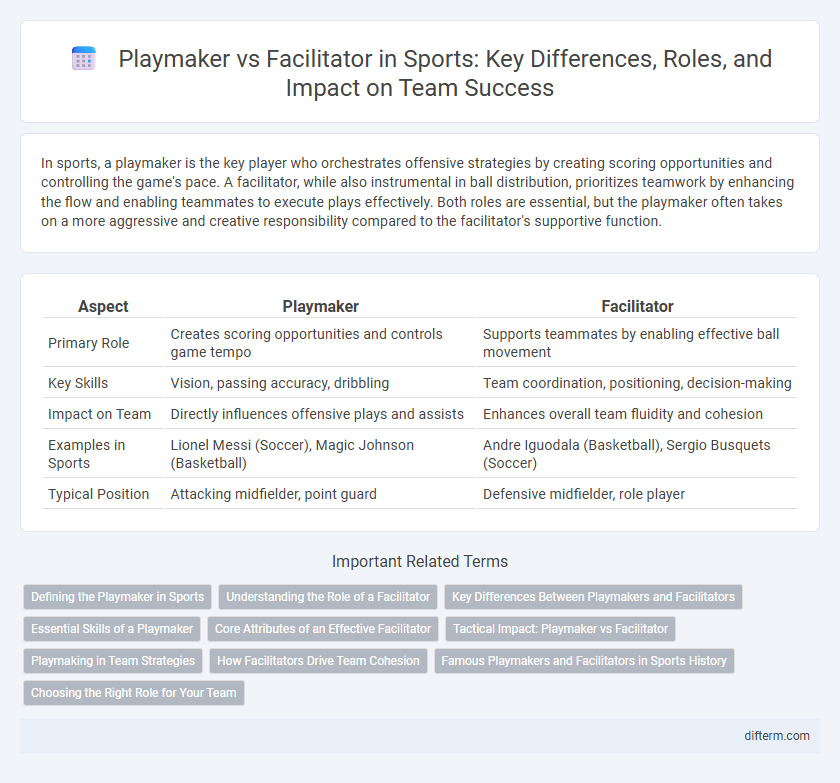In sports, a playmaker is the key player who orchestrates offensive strategies by creating scoring opportunities and controlling the game's pace. A facilitator, while also instrumental in ball distribution, prioritizes teamwork by enhancing the flow and enabling teammates to execute plays effectively. Both roles are essential, but the playmaker often takes on a more aggressive and creative responsibility compared to the facilitator's supportive function.
Table of Comparison
| Aspect | Playmaker | Facilitator |
|---|---|---|
| Primary Role | Creates scoring opportunities and controls game tempo | Supports teammates by enabling effective ball movement |
| Key Skills | Vision, passing accuracy, dribbling | Team coordination, positioning, decision-making |
| Impact on Team | Directly influences offensive plays and assists | Enhances overall team fluidity and cohesion |
| Examples in Sports | Lionel Messi (Soccer), Magic Johnson (Basketball) | Andre Iguodala (Basketball), Sergio Busquets (Soccer) |
| Typical Position | Attacking midfielder, point guard | Defensive midfielder, role player |
Defining the Playmaker in Sports
The playmaker in sports is a key athlete responsible for orchestrating offensive strategies and creating scoring opportunities. Unlike a facilitator who primarily supports ball distribution, the playmaker possesses exceptional vision, decision-making, and technical skills that drive team dynamics and influence game outcomes. Renowned playmakers like Lionel Messi in soccer or Chris Paul in basketball exemplify the pivotal role of this position in elevating team performance through creative and tactical leadership.
Understanding the Role of a Facilitator
A facilitator in sports orchestrates team dynamics by enhancing communication and positioning, enabling players to execute strategies seamlessly. Unlike a playmaker who directly controls the game's pace and creates scoring opportunities, the facilitator focuses on maintaining flow and connecting teammates efficiently. Mastering the facilitator role improves overall team cohesion and maximizes collective performance on the field.
Key Differences Between Playmakers and Facilitators
Playmakers are central figures in sports like soccer and basketball who control the tempo and create scoring opportunities through skillful ball handling and vision. Facilitators primarily assist teammates by distributing the ball strategically, emphasizing teamwork and positioning over individual creativity. The key difference lies in playmakers driving offensive plays actively, whereas facilitators enable fluid team dynamics through support and passing.
Essential Skills of a Playmaker
A playmaker excels in vision, creativity, and decision-making, orchestrating the game's flow by anticipating opponents' moves and exploiting gaps. Essential skills include precise passing, spatial awareness, and the ability to maintain composure under pressure to execute key plays. Mastery of these abilities enables a playmaker to control tempo and create scoring opportunities, distinguishing them from a facilitator who primarily supports without initiating.
Core Attributes of an Effective Facilitator
An effective facilitator in sports demonstrates exceptional communication skills, enabling clear and concise information flow among team members. They possess strong emotional intelligence to manage group dynamics and foster collaboration, ensuring all voices are heard. Mastery of conflict resolution and adaptability further distinguishes facilitators, as they guide teams through challenges to maintain focus on collective goals.
Tactical Impact: Playmaker vs Facilitator
The tactical impact of a playmaker centers on orchestrating offensive strategies by creating scoring opportunities and dictating the game's tempo through advanced vision and precise passing. Facilitators enhance team dynamics by efficiently distributing the ball, maintaining possession, and enabling fluid transitions between defense and attack without necessarily being the primary creator. While playmakers often assume a more creative role with higher risk-reward potential, facilitators prioritize stability and support, optimizing overall team cohesion and tactical balance.
Playmaking in Team Strategies
Playmaking in team strategies revolves around a player's ability to create scoring opportunities through vision, creativity, and precise passing. Unlike a facilitator who mainly distributes the ball, a playmaker actively influences the tempo and direction of the game by orchestrating offensive moves and exploiting defensive weaknesses. Effective playmakers are essential in breaking down opposing defenses and setting the rhythm that dictates the team's attacking flow.
How Facilitators Drive Team Cohesion
Facilitators enhance team cohesion by distributing opportunities and maintaining fluid communication among players, ensuring each member contributes effectively to the game plan. Unlike playmakers who often control ball handling, facilitators prioritize creating connections, enabling seamless transitions and strategic positioning on the field. Their ability to read the game and anticipate teammates' movements fosters trust and adaptability, crucial elements for unified team performance.
Famous Playmakers and Facilitators in Sports History
Famous playmakers like Lionel Messi and Magic Johnson revolutionized their sports with creative vision and decisive ball distribution, shaping game outcomes through skillful control. Renowned facilitators such as Steve Nash and Xavi Hernandez excelled in orchestrating team dynamics by setting up scoring opportunities and enhancing overall team performance. Their unique blend of strategic thinking and on-field intelligence distinguishes playmakers and facilitators as pivotal figures in football and basketball history.
Choosing the Right Role for Your Team
Selecting between a playmaker and a facilitator depends on your team's strategic goals and player skill sets. A playmaker excels at creating scoring opportunities through vision and creativity, often driving offensive momentum, while a facilitator prioritizes ball distribution and maintaining team rhythm, optimizing collective involvement. Assessing player strengths and team dynamics ensures the chosen role maximizes offensive efficiency and cohesion.
playmaker vs facilitator Infographic

 difterm.com
difterm.com